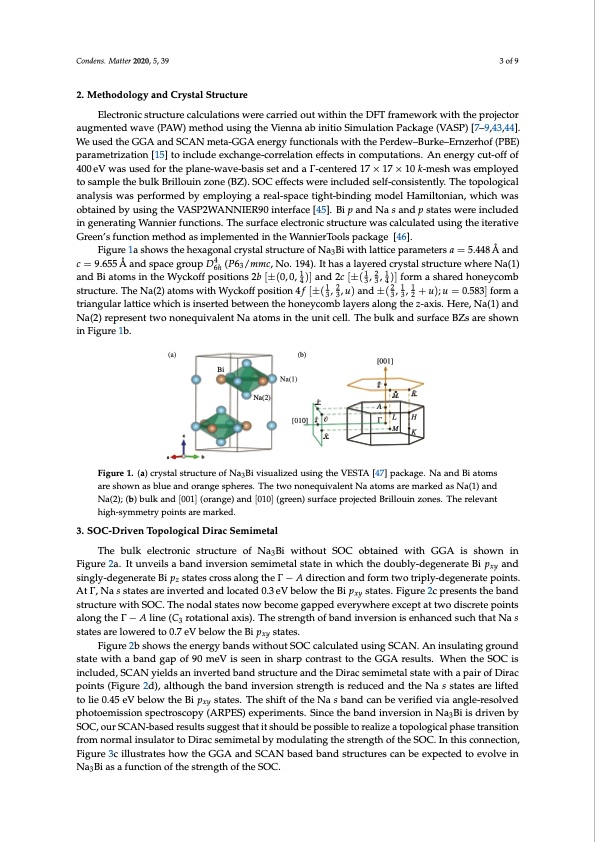
PDF Publication Title:
Text from PDF Page: 003
Condens. Matter 2020, 5, 39 3 of 9 2. Methodology and Crystal Structure Electronic structure calculations were carried out within the DFT framework with the projector augmented wave (PAW) method using the Vienna ab initio Simulation Package (VASP) [7–9,43,44]. We used the GGA and SCAN meta-GGA energy functionals with the Perdew–Burke–Ernzerhof (PBE) parametrization [15] to include exchange-correlation effects in computations. An energy cut-off of 400 eV was used for the plane-wave-basis set and a Γ-centered 17 × 17 × 10 k-mesh was employed to sample the bulk Brillouin zone (BZ). SOC effects were included self-consistently. The topological analysis was performed by employing a real-space tight-binding model Hamiltonian, which was obtained by using the VASP2WANNIER90 interface [45]. Bi p and Na s and p states were included in generating Wannier functions. The surface electronic structure was calculated using the iterative Green’s function method as implemented in the WannierTools package [46]. Figure 1a shows the hexagonal crystal structure of Na3Bi with lattice parameters a = 5.448 Å and c = 9.655 Å and space group D64h (P63/mmc, No. 194). It has a layered crystal structure where Na(1) and Bi atoms in the Wyckoff positions 2b [±(0, 0, 14 )] and 2c [±( 13 , 23 , 14 )] form a shared honeycomb structure.TheNa(2)atomswithWyckoffposition4f [±(13,23,u)and±(32,13,12 +u);u=0.583]forma triangular lattice which is inserted between the honeycomb layers along the z-axis. Here, Na(1) and Na(2) represent two nonequivalent Na atoms in the unit cell. The bulk and surface BZs are shown in Figure 1b. (a) Bi (b) Na(1) Na(2) [010] Γ [001] A LH M K Figure 1. (a) crystal structure of Na3Bi visualized using the VESTA [47] package. Na and Bi atoms are shown as blue and orange spheres. The two nonequivalent Na atoms are marked as Na(1) and Na(2); (b) bulk and [001] (orange) and [010] (green) surface projected Brillouin zones. The relevant high-symmetry points are marked. 3. SOC-Driven Topological Dirac Semimetal The bulk electronic structure of Na3Bi without SOC obtained with GGA is shown in Figure 2a. It unveils a band inversion semimetal state in which the doubly-degenerate Bi pxy and singly-degenerate Bi pz states cross along the Γ − A direction and form two triply-degenerate points. At Γ, Na s states are inverted and located 0.3 eV below the Bi pxy states. Figure 2c presents the band structure with SOC. The nodal states now become gapped everywhere except at two discrete points along the Γ − A line (C3 rotational axis). The strength of band inversion is enhanced such that Na s states are lowered to 0.7 eV below the Bi pxy states. Figure 2b shows the energy bands without SOC calculated using SCAN. An insulating ground state with a band gap of 90 meV is seen in sharp contrast to the GGA results. When the SOC is included, SCAN yields an inverted band structure and the Dirac semimetal state with a pair of Dirac points (Figure 2d), although the band inversion strength is reduced and the Na s states are lifted to lie 0.45 eV below the Bi pxy states. The shift of the Na s band can be verified via angle-resolved photoemission spectroscopy (ARPES) experiments. Since the band inversion in Na3Bi is driven by SOC, our SCAN-based results suggest that it should be possible to realize a topological phase transition from normal insulator to Dirac semimetal by modulating the strength of the SOC. In this connection, Figure 3c illustrates how the GGA and SCAN based band structures can be expected to evolve in Na3Bi as a function of the strength of the SOC.PDF Image | Topological Dirac Semimetal Phase in Bismuth Based Anode Materials for Sodium-Ion Batteries

PDF Search Title:
Topological Dirac Semimetal Phase in Bismuth Based Anode Materials for Sodium-Ion BatteriesOriginal File Name Searched:
condensedmatter-05-00039-v3.pdfDIY PDF Search: Google It | Yahoo | Bing
Sulfur Deposition on Carbon Nanofibers using Supercritical CO2 Sulfur Deposition on Carbon Nanofibers using Supercritical CO2. Gamma sulfur also known as mother of pearl sulfur and nacreous sulfur... More Info
CO2 Organic Rankine Cycle Experimenter Platform The supercritical CO2 phase change system is both a heat pump and organic rankine cycle which can be used for those purposes and as a supercritical extractor for advanced subcritical and supercritical extraction technology. Uses include producing nanoparticles, precious metal CO2 extraction, lithium battery recycling, and other applications... More Info
| CONTACT TEL: 608-238-6001 Email: greg@infinityturbine.com | RSS | AMP |